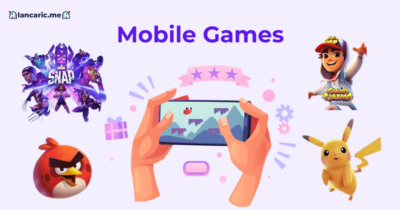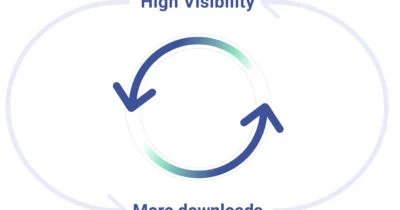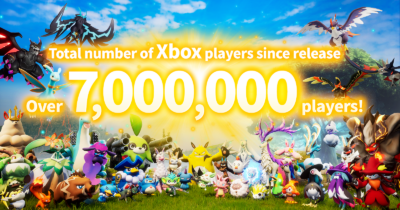
Mobile Games: User Acquisition, Retention, Monetization & Case Studies
Mobile games are digital gaming experiences designed specifically for play on mobile devices such as smartphones and tablets. They encompass a wide range of genres from casual games like puzzle and card games to more complex role-playing and strategy games. The rise of mobile gaming has been driven by advancements in smartphone technology, improved internet connectivity, and the availability of app stores that make games easily accessible to a broad audience.
Top mobile games are fortnite, minecraft, dinosaur game, among us, retro bowl, stardew valley, genshin impact, pokémon go, terraria, monument valley, bubble shooter, google feud, threes, stickman hook, marvel snap, crossy road, squad busters, angry birds by Rovio, legend of slime, hero wars, monopoly go, duolingo, brawl stars, survivor.io, frozen city, top troops, supercell’s clash mini, diggy’s adventure, supercell mo co, supercell floodrush, and ants underground kingdom.
Best monetization strategies for mobile games are in-app purchases, advertising, data monetization, rewarded ads, freemium models, paid games, interstitial ads, in-app ads, and subscription models. The monetization strategies help developers generate revenue while offering a balanced user experience.
This guide explores the essential strategies for user acquisition, retention and monetization in mobile games, complemented by insightful case studies that illustrate successful implementations in the competitive gaming landscape.
What are Mobile Games?
Mobile games are video games designed to be played on smartphones or tablets. They range from simple casual games to complex immersive gaming experiences. Mobile games offer touch controls, connectivity features and various monetization models like in-app purchases or ads.
How to Develop a Mobile Game?
To develop a mobile game, design a strong game idea, create a design document, focus on user experience (UX) and user interface (UI), choose a game engine, develop game mechanics, and design graphics, test for bugs and optimize app performance.
What is Soft Launch?
A soft launch is the release of a mobile game to a limited audience or region. The purpose is to test performance, gather user feedback, and identify issues before a full-scale launch to a wider market.
A soft launch is important for mobile games because the launch allows developers to test key aspects like user experience (UX), user interface (UI), and overall gameplay with a smaller, controlled audience. The soft launch process helps identify bugs, optimize performance, and gather valuable user feedback that helps in adjustments before the full release. Soft launch also helps in understanding the game’s appeal, retention rates, and monetization strategies for a smoother and more successful global launch with fewer risks. By addressing potential issues early on, the soft launch increases the chances of the game’s long-term success in the competitive mobile gaming market.
What is Global Launch?
A global launch is the full release of a mobile game across all intended markets after successful testing in specific regions. Global launch follows a soft launch by targeting a wider audience for maximum reach, revenue generation, and user acquisition.
A global launch is important for mobile games as the launch on a global level allows developers to reach a wider audience and maximize their potential revenue. Global launch helps solidify the game’s presence in competitive markets and leads to long-term success. By launching globally, developers gain valuable user feedback on a large scale, identify performance issues across different devices and regions, and refine monetization strategies to optimize revenue streams. The global launch also sets the stage for marketing and user acquisition efforts to boost the game’s visibility and player base worldwide.
What is Mobile Game User Acquisition?
Mobile game user acquisition refers to the strategies and methods used to attract and convert new players to download and engage with a mobile game through advertising, partnerships, social media and app store optimization (ASO).
Mobile game user acquisition works by attracting new players through targeted marketing strategies designed to increase downloads and engagement. Developers use channels like social media, in-app advertising, influencer marketing, app store optimization, incentivized installs, and paid ads to reach potential players. Once a campaign is launched, metrics like Cost Per Install (CPI), Click-Through Rate (CTR), and Conversion Rate are tracked to measure the effectiveness of the efforts. By analyzing user behavior and optimizing campaigns, developers fine-tune their approach to acquire users who are more likely to engage, retain, and eventually spend money within the game.
What is User Acquisition Cost for Mobile Games?
User Acquisition Cost (UAC) for mobile games is the average amount of money spent on marketing and advertising to acquire a single new player or user for a mobile game.
User Acquisition Cost (UAC) is important for mobile games because UAC helps developers understand how much they are spending to gain each new player. By tracking UAC, developers measure the efficiency of their marketing efforts and make sure they are getting a good return on investment (ROI). A lower UAC means acquiring users at a lower cost that is essential for profitability, especially in competitive markets. UAC also helps in optimizing marketing budgets by focusing on channels and strategies that attract high-value users who are likely to stay engaged and make in-app purchases.
What are the Best User Acquisition Strategies?
The best user acquisition strategies include search engine optimization (SEO), app store optimization (ASO), social media marketing, influencer marketing, paid user acquisition (UA) campaigns, referral programs, content marketing strategy, pre-launch marketing, in-app events and promotions, retargeting campaigns, and localized marketing.
Let’s check out what makes each user acquisition strategy the best:
- Search Engine Optimization (SEO):
SEO (Search Engine Optimization) is the process of optimizing a website’s content, structure, and visibility to improve website’s ranking on search engine results pages. Search Engine Optimization (SEO) works as a user acquisition strategy by improving a mobile game’s visibility on search engines like Google or app stores. By optimizing keywords, descriptions, and content relevant to the game, developers increase the chances that potential players will find the game when searching for related terms. SEO helps drive organic traffic, reduce reliance on paid ads, and lower acquisition costs. A well-optimized game page improves credibility and attracts high-intent users who are more likely to download and engage with the game.
- App Store Optimization (ASO):
App Store Optimization (ASO) is the process of enhancing a mobile app’s visibility and ranking in app stores such as the Apple App Store and Google Play by optimizing the app’s title, keywords, description, visuals, and user engagement metrics. App Store Optimization (ASO) works as a user acquisition strategy by enhancing a mobile game’s visibility within app stores like Google Play and Apple’s App Store. ASO involves optimizing elements such as the game’s title, description, keywords, screenshots, and app icon to improve the app’s ranking in search results and appeal to potential users. The goal is to attract more organic downloads by making the game easier to find for users searching for related terms. Effective ASO boosts visibility and increases conversion rates because users are more likely to download an app that looks appealing and relevant.
- Social Media Marketing:
Social media marketing is the practice of using social media platforms to promote products, services, or brands by creating and sharing content, engaging with users, and running targeted advertising campaigns. Social Media Marketing works as a user acquisition strategy by using platforms like Facebook, Instagram, TikTok, and Twitter to promote mobile games to a broad audience. Through targeted ads, engaging posts, influencer collaborations, and community building, developers attract potential players and drive game downloads. Social media allows for precise targeting based on demographics, interests, and behaviors and makes sure that the ads are reaching users who are likely to engage with the game. Social media marketing helps create buzz around a game, encourages word-of-mouth, and builds a loyal player base.
- Influencer Marketing:
Influencer marketing is a strategy where brands collaborate with social media influencers or content creators to promote their products or services to the influencer’s audience. Influencer Marketing works as a user acquisition strategy by partnering with influencers that are individuals with large and engaged audiences on platforms like YouTube, Twitch, or Instagram to promote mobile games. The influencers create content such as gameplay videos, reviews, or live streams showcasing the game to their followers. Since influencers have a trusted relationship with their audience, their endorsement drives interest and encourages downloads among their fanbase. The influencer marketing strategy helps reach niche or large audiences, builds credibility for the game, and results in highly engaged users who trust the influencer’s recommendations.
- Paid User Acquisition (UA) Campaigns:
Paid User Acquisition (UA) campaigns are marketing efforts where businesses invest in paid channels such as social media ads, search ads, and display networks, to attract new users to their apps, websites, or products. Paid User Acquisition (UA) campaigns work as a user acquisition strategy by using paid ads to drive targeted traffic and downloads for a mobile game. The UA campaigns involve running ads on platforms like Google, Facebook, Instagram, or TikTok, where ads are customized to specific user segments based on demographics, behaviors, or interests. By investing in paid UA campaigns, game developers attract a steady flow of new players quickly and effectively. The ads are optimized for app installs or user actions to confirm that the game reaches users who are likely to engage and convert. Paid UA campaigns are essential for scaling user growth and expanding the game’s player base efficiently.
- Referral Programs:
Referral programs incentivize existing users or customers to invite others to use a product or service by offering rewards such as discounts or credits, to both the referrer and the referred.
Referral programs work as a user acquisition strategy by incentivizing existing players to invite new users to download and engage with a mobile game. Participants receive rewards such as in-game currency, exclusive items, or bonuses for each successful referral they make. The referral strategy uses the social networks of current players to expand the game’s reach organically because users are more likely to trust recommendations from friends or family. Referral programs drive new installs and promote player retention because users who are referred by friends have a higher level of engagement and longer-term interest in the game.
- Content Marketing:
Content marketing is a strategy focused on creating and distributing valuable, relevant, and consistent content to attract and engage a target audience. Content marketing works as a user acquisition strategy by creating and distributing valuable, relevant, and engaging content to attract and retain potential players for a mobile game. The content marketing approach includes producing blog posts, videos, infographics, and social media updates that highlight the game’s features, gameplay strategies, or related topics that resonate with the target audience. By providing informative or entertaining content, developers build brand awareness, establish authority, and drive traffic to the game’s download page. Content marketing helps capture the interest of potential users, encourages organic sharing, and nurtures a community around the game.
- Pre-Launch Marketing:
Pre-launch marketing involves promoting a product or service before the official release to build anticipation, generate buzz, and attract potential customers or users through strategies such as teasers, early access, and targeted campaigns. Pre-launch marketing works as a user acquisition strategy by generating buzz and building anticipation for a mobile game before the official release. The pre-launching strategy involves creating teaser campaigns, engaging potential players through social media, running beta tests, and sharing sneak peeks or exclusive content to create excitement and capture interest. By using tactics such as influencer partnerships, early access promotions, and email sign-ups, developers build a pre-launch user base. Effective pre-launch marketing helps establish a community of eager players and results in a successful launch and sustained momentum as the game goes live.
- In-App Events and Promotions:
In-app events and promotions are marketing activities within a mobile app that offer special deals, limited-time offers, or engaging experiences to encourage user participation, retention, and increased in-app spending. In-App Events and Promotions work as a user acquisition strategy by offering special events, limited-time offers, or exclusive in-game content to attract and retain players. The events include seasonal challenges, themed activities, or promotional sales that encourage both new and existing users to engage with the game more frequently. By creating a sense of urgency and excitement, developers drive increased downloads and player activity, and incentivize current users to invite friends or participate more actively. The in-app promotion strategy boosts user acquisition and enhances player retention by keeping the game dynamic and engaging.
- Retargeting Campaigns:
Retargeting campaigns are advertising strategies that target users who have previously interacted with a brand or website to re-engage them and drive conversions by reminding them of products or services they showed interest in. Retargeting campaigns work as a user acquisition strategy by targeting users who have previously interacted with the mobile game or the ads but have not yet completed a desired action such as making a purchase or installing the game. The retargeting campaigns use data on user behavior to deliver personalized ads that remind and inspire the potential players to return and take action. By focusing on users who have already shown interest, retargeting campaigns improve conversion rates and cost-effectively re-engage potential players.
- Localized Marketing:
Localized marketing customizes advertising and promotional efforts to specific geographic regions or cultural groups to better resonate with local audiences and address their unique preferences and needs.Localized marketing works as a user acquisition strategy by customizing promotional efforts to specific geographic regions, languages, and cultural contexts to better resonate with local audiences. The localized marketing involves adapting the game’s content, advertisements, and messaging to align with regional preferences and trends that significantly improve engagement and download rates. By addressing the unique needs and interests of different markets, localized marketing enhances relevance and leads to more effective user acquisition. Localized marketing helps overcome cultural barriers, increases the game’s visibility in diverse regions, and builds a stronger connection with players.
What are the Best Strategies for User Retention and Engagement?
The best strategies for user retention and engagement include promoting brand loyalty, collecting customer feedback, improving the onboarding process, using gamification, building a community, creating personalized user experiences, exceeding customer expectations, improving customer support, and doing monetization without causing frustration.
Here’s a quick overview of the best strategies for user retention and engagement:
- Brand loyalty:
Brand loyalty is the consistent preference and commitment of consumers to repeatedly purchase or engage with a specific brand over the brand’s competitors due to positive experiences, trust, and emotional connection with the brand.Brand loyalty plays an important role in user retention and engagement by building a strong emotional connection between players and the mobile game. When users trust and enjoy a game, they are more likely to keep playing, engage with in-game content, and recommend the game to others. The brand loyalty is built through positive user experiences, consistent updates, and rewarding gameplay that meets or exceeds player expectations. As users become more invested in the game and the brand, they stay longer and engage more deeply. Users then also participate in community events, make in-app purchases, or explore new game features. Ultimately, brand loyalty strengthens retention, boosts engagement, and contributes to long-term success.
- Collect customer feedback
Customer feedback is the information and opinions provided by consumers about their experiences with a product or service that helps businesses improve offerings, enhance customer satisfaction, and drive innovation. Collecting customer feedback is essential for user retention and engagement as customer feedback allows game developers to understand players’ needs, preferences, and pain points. By actively listening to user input, game developers make targeted improvements, fix issues, and introduce new features that align with player expectations to make the game enjoyable and relevant. Engaging with feedback also shows players that their opinions are valued and builds a sense of community and loyalty. The continuous feedback loop helps retain existing users by keeping the game fresh and responsive and encourages deeper engagement as players feel more connected and invested in the game’s success.
- Improve the onboarding process
Improving the onboarding process involves optimizing the steps and user experience for new customers or users to quickly understand, engage with, and successfully use a product or service. Improving the onboarding process is critical for user retention and engagement because the onboarding process sets the tone for a player’s entire experience with a mobile game. A smooth, intuitive onboarding helps new players quickly understand the game’s mechanics, features, and goals, reducing frustration and confusion. When players are introduced to the game effectively, they are more likely to feel confident and excited to continue playing. A well-designed onboarding highlights key aspects of the game that keep players engaged such as rewards or progression systems. Ultimately, improving onboarding boosts retention by making sure that new users don’t drop off early and are encouraged to explore and enjoy the game fully.
- Use gamification
Gamification is the integration of game-like elements such as points, badges, challenges, and rewards into non-game contexts to engage users and enhance their experience. Using gamification for user retention and engagement uses game-like elements such as points, badges, levels, and challenges to keep users motivated and invested. By incorporating the game-like elements, mobile games create a sense of achievement and progression that encourages players to keep playing. Gamification also taps into users’ competitive spirit by offering rewards for completing tasks or reaching milestones and fostering a deeper emotional connection to the game. Using gamification keeps the gameplay dynamic and fun and makes players feel accomplished while enticing them to return regularly.
- Build a community
Building a community involves creating and nurturing a group of people with shared interests or goals, promoting interaction, support, and engagement through platforms, events, or content.
Building a community for user retention and engagement involves creating a space where players interact, share experiences, and form connections around a game. When users feel part of a community, they are more likely to remain loyal to the game beecause community fosters a sense of belonging and shared purpose. Features like chat rooms, forums, or social media groups allow users to discuss strategies, celebrate achievements, or collaborate on in-game events. The social interaction enhances the overall gaming experience, encouraging players to stay active, return frequently, and engage more deeply with the game and each other.
- Create personalized customer experiences
Personalized customer experiences customize interactions, content, and recommendations to individual preferences, behaviors, and needs by creating a more relevant and engaging journey for each customer. Creating personalized customer experiences for user retention and engagement involves customizing the gaming experience to individual preferences, habits, and behaviors. By offering customized content, rewards, and gameplay based on a player’s in-game actions or preferences, users feel more connected and valued. Personalized notifications, targeted promotions, and individualized recommendations enhance engagement by making the experience feel unique to each player. The personal touch increases satisfaction and loyalty because users are more likely to return and invest time in a game that adapts to their specific needs.
- Exceed customer expectations
Customer expectations are the preconceived beliefs or standards that consumers have regarding the quality, service, and overall experience they should receive from a brand or product. Exceeding customer expectations for user retention and engagement means delivering more value and a better experience than users anticipate. Exceeding user expectations involve surprising players with bonus content, unexpected rewards, or exceptional customer support that goes beyond the norm. By consistently offering features, updates, or services that surpass what players expect, you create a sense of delight and loyalty. When users feel like they’re receiving more than they paid for or that their needs are truly understood they’re more likely to stay engaged with the game and continue playing.
- Improve your customer support
Customer support is the assistance and guidance provided by a company to help customers resolve issues, answer questions, and provide a positive experience with the products or services. Improving your customer support directly enhances user retention and engagement by making the players feel valued and heard. Quick and effective resolutions to issues, whether through in-game support or external channels, create a positive experience even when problems arise. Offering personalized assistance, addressing concerns promptly, and maintaining open communication builds trust and loyalty. When users know they rely on support when needed they’re more likely to stay engaged with your game and build a strong relationship that keeps them coming back and encourages long-term retention.
- Monetization Without Frustration
Monetization without frustration refers to implementing revenue-generating strategies such as ads or in-app purchases in a way that enhances user experience rather than disrupting or frustrating that experience. Monetization without frustration works for user retention and engagement by offering players a way to enjoy the game without feeling forced to spend money or deal with disruptive ads. Striking a balance between monetization and gameplay such as using non-intrusive ads, fair in-app purchases, or well-timed offers confirms that players don’t feel pressured or frustrated. The approach keeps the gaming experience enjoyable while allowing for revenue generation. When users feel respected and not overwhelmed by monetization tactics, they are more likely to stay engaged and remain loyal to the game.








